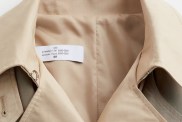Giorgio Armani for Italy, Christian Louboutin and former French professional handball player turned retailer Henry Tai for Cuba, Masha Ma for China, Stella McCartney for Great Britain (and ASOS for its Paralympic team), Ralph Lauren Polo for the United States — the Olympics’ opening and closing ceremonies in many ways double as international fashion runways. (Aptly, supermodel Gisele Bündchen is even hosting.)
Similarly, the Olympics is the great interactive showcase for designers in the world of wearable technology — and we’re not talking Apple Watches. For sportswear giants like Nike, Adidas and Puma that clothe everyone from your average yogi to LeBron James, outfitting the world’s most talented athletes for the ultimate competition is akin to creating a couture collection. The “seamstresses” of the athletic wear world prepare for months on end, knowing that even the smallest details can be critical to the wearer’s performance. Ultimately, the Olympians act both as models and part of the piece, their success often determining that of their specially crafted sportswear.

Avril Graham of Harper’s Bazaar at New York Fashion Week Spring 2016; Image: Bennett Raglin/WireImage
Harper’s Bazaar Executive Fashion and Beauty Editor Avril Graham is a bona fide expert when it comes to the intersection between style, technology and the Olympics. To wit: Graham served as a fashion and lifestyle expert for the 2012 Olympic Games in London and will also be attending the 2016 Olympic Games in Rio. Always on the quest to optimize our workouts and athleisure game, we caught up with the fashion and activewear aficionado to discuss the evolution of Olympic outfits and how athletes have used technology in their sports.
theFashionSpot: When was the first time technology was integrated into the Olympic outfits?
Avril Graham: Arguably, you could say that technology has been incorporated into outfits worn by Olympians literally since the athletes began wearing clothing at all. Although clothing actually may have ended up slowing down and hindering athletes in some decades due to the modesty rules during the late 1800s through turn of the century when rules on hemlines and covering up were so cumbersome, particularly for women…it was a battle of respectability (and often of the sexes) with the impractical official doctrine laid down on the apparel worn for various sports at the time.
tFS: How would you describe the role of fashion in the Olympic Games?
AG: Fashion is so incredibly well represented throughout the Olympic Games in current times. From the elegantly smart, sporty and tailored looks presented by the national teams at the opening ceremony from high-end designers, such as Ralph Lauren, Stella McCartney and Giorgio Armani — through to off-duty and high-tech performance wear, which the major well-known sports brands work together with highly specialized scientific teams to develop the most innovative high-performance sportswear.
The actual competitive wear is a strategic combination of not only what looks good, but performs to extraordinary standards, too. The major sportswear companies, such as Nike, Puma and Adidas have been working to constantly upgrade, revolutionize and perfect the high-performance clothing, helmets, footwear and equipment to help propel athletes to achieve their true potential. Fashion is important, literally everywhere during the Games.

Usain Bolt tears down the track in Puma during the men’s 200m on Day One of the Muller Anniversary Games; Image: Christopher Lee/Getty Images
tFS: Do you think the technology determines who wins in some cases?
AG: Specifically designed kits help muscular performance and reduce fatigue, boost recovery. The biggest star athletes have only the best technology applied to help and boost performance. For track and field, the focus is on lightweight flex footwear with the right dimension of fit spikes.
Nike, for example, has revealed their Nike Vapor Track and Field Kits and feature items that incorporate AeroSwift technology and are made with recycled polyester. This fabric is 25 percent more moisture wicking, quicker drying and 10 percent lighter. The uniforms feature 50 percent more stretch…they tell us the texture is fast. The AeroBlades are almost like a golf ball. It has texture to cut through the air.
And we’ve been told that Gold Medalist Usain Bolt will be wearing the ultra-new latest version of the Puma Ignite Disc running shoe with the evoSPEED Disc Spike racing flat featuring their Disc dial system.
tFS: What would you say was the most game-changing technology when it came to outfitting Olympians?
AG: Swim-tech is arguably one of the most competitive when it comes to technology, really shaving the milliseconds off a score and where victory and defeat can have everything to do with streamlining movement and ease in the water. And accordingly, brands compete to provide the world’s fastest swimsuit. Seven years ago controversial high-tech swimsuits were banned and now there is something of an epic competitive spirit between brands to gain speed and momentum for Olympic swimmers in the pool. Brands, such as Arena and Speedo specifically are locked into devising the best apparel for swimmers. I also hear that Speedo’s special edition of the LZR Racer X and LZR Racer 2 is expected to be worn by Missy Franklin, Nathan Allen and Ryan Lochte and feature fabric that can stretch in just one direction giving better aerodynamic pull in the water.

Michael Phelps demonstrates his prowess during Day Seven of the 2016 U.S. Olympic Team Swimming Trials; Image: Tom Pennington/Getty Images
tFS: What’s the most elaborate piece of technology an Olympian has ever worn?
AG: Research shows that Michael Phelps has worked directly with Aqua Sphere to develop and redesign the concept of the racing swimsuit, creating the Xpresso suit. He also wanted new high-performance goggles — low-profile ones that allowed him an increased range of vision underwater. And even wrinkling swim caps (leading to increased drag) were a concern and could be upgraded he thought. Using 3-D models of Phelps’ head, the company designed a swim cap with silicone panels thicker than usual on each side of his head to keep the cap in place. He wanted to be flexible with a suit of hydrodynamic properties, something from a suit that made him swim more naturally. And according to experts, his new suit takes only 10 minutes to put on, unlike the previous compression versions that were so tight it often took 30 minutes to get into them.
We have come a long way from the weighty, long-sleeve wool swimsuits and judging by Phelps’ results in trials, modern technology, with the help and suggestion of the multi gold-winning athlete, has a lot going for it.







